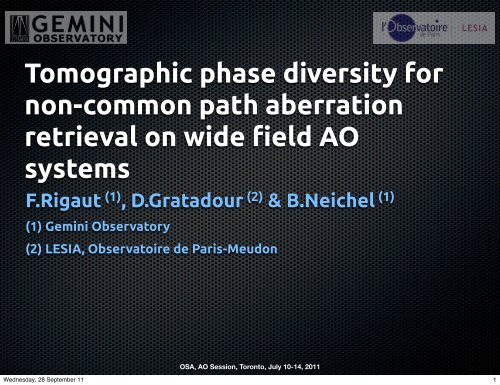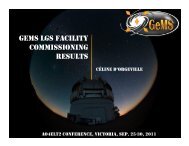Tomographic phase diversity for non-common path ... - AO4ELT 2
Tomographic phase diversity for non-common path ... - AO4ELT 2
Tomographic phase diversity for non-common path ... - AO4ELT 2
You also want an ePaper? Increase the reach of your titles
YUMPU automatically turns print PDFs into web optimized ePapers that Google loves.
<strong>Tomographic</strong> <strong>phase</strong> <strong>diversity</strong> <strong>for</strong><br />
<strong>non</strong>-<strong>common</strong> <strong>path</strong> aberration<br />
retrieval on wide field AO<br />
systems<br />
F.Rigaut (1) , D.Gratadour (2) & B.Neichel (1)<br />
(1) Gemini Observatory<br />
(2) LESIA, Observatoire de Paris-Meudon<br />
OSA, AO Session, Toronto, July 10-14, 2011<br />
Wednesday, 28 September 11<br />
1
Motivations<br />
Wide field AO systems require dedicated methods <strong>for</strong><br />
<strong>non</strong>-<strong>common</strong> <strong>path</strong> aberration (NCPA) correction to<br />
cancel aberrations simultaneously over the entire FoV<br />
Use a focal-based approach:<br />
optimize image where it needs to be optimized<br />
easy to acquire many measurement points simultaneously<br />
saves hardware<br />
Leverage Phase Diversity (PD), a known and proven<br />
technique (Paxman et al 1982, Blanc et al 2003,<br />
Hartung et al 2003)<br />
On cal source: simplified PD, straight<strong>for</strong>ward object<br />
Kolb (2006): wide field capable but not intrinsically<br />
tomographic<br />
OSA, AO Session, Toronto, July 10-14, 2011<br />
Wednesday, 28 September 11<br />
2
NCPA initial approach<br />
<strong>for</strong> GeMS<br />
Multiple (typ. 9) 24x24 SHWFS<br />
measurements spanning the<br />
85”x85” FoV<br />
Feed to <strong>Tomographic</strong><br />
reconstructor (synthetic)<br />
➜ <strong>phase</strong> @ multiple altitude<br />
Project on LGS WFS slopes<br />
Typical per<strong>for</strong>mance, average<br />
over field of view:<br />
from SH ~ 5 to 50% (inc. astigs)<br />
to SH ~ 95%<br />
OSA, AO Session, Toronto, July 10-14, 2011<br />
Wednesday, 28 September 11<br />
3
Example of preliminary SHWFS + tomography<br />
<strong>AO4ELT</strong>s2, Victoria/Canada, September 26-30, 2011<br />
Wednesday, 28 September 11<br />
4
NCPA issues <strong>for</strong> wide field systems<br />
Impossibility to compensate <strong>for</strong> anything that’s not<br />
occuring close to the DM altitude !<br />
Beware optical designers<br />
Need to multiplex <strong>for</strong> efficient/quick convergence<br />
MCAO: funky effects induced by WFSs differential<br />
aberrations (finite range, off-axis LGS sources). Lead to<br />
<strong>non</strong> tomographic error. Funny reconstruction<br />
MCAO tips and tricks: Filtering of quadratics<br />
General note: Zernikes are well known, but bad when<br />
considering N>~80 due to extreme edge slopes.<br />
A good replacement are KL or Disk Harmonic<br />
OSA, AO Session, Toronto, July 10-14, 2011<br />
Wednesday, 28 September 11<br />
5
Two new ideas (as far as I know ?)<br />
<strong>Tomographic</strong> <strong>phase</strong> <strong>diversity</strong>:<br />
The classical PD approach can be extended to process data over<br />
an extended field of view.<br />
Instead of solving <strong>for</strong> a 2D <strong>phase</strong>, solve <strong>for</strong> a 3D <strong>phase</strong> (discrete<br />
or continuous). E.g 2-3 <strong>phase</strong> planes + a tomographic projector<br />
Naturally more overconstrained/robust than PD in individual<br />
direction + tomographic reconstruction (assuming # of field<br />
positions/images is larger than the # of <strong>phase</strong> planes).<br />
The PD minimisation criterion can be expressed in the<br />
Fourier plane (OTF-based <strong>phase</strong> <strong>diversity</strong>)<br />
(Potentially) saves one Fourier trans<strong>for</strong>m<br />
Allow weighting per spatial frequencies<br />
✚ I will present 2 packages developed by D.Gratadour<br />
(PRAy, image based) and F.Rigaut (OPRA, OTF-based)<br />
OSA, AO Session, Toronto, July 10-14, 2011<br />
Wednesday, 28 September 11<br />
6
“Classical” PD<br />
2D-<strong>phase</strong><br />
PSF<br />
Vib Kernel<br />
Object<br />
Minimization<br />
method<br />
Model<br />
Data<br />
Criterion<br />
Single focal<br />
plane point<br />
OSA, AO Session, Toronto, July 10-14, 2011<br />
Wednesday, 28 September 11<br />
7
“<strong>Tomographic</strong>” PD<br />
3D-<strong>phase</strong><br />
PSF<br />
Vib Kernel<br />
Object<br />
Minimization<br />
method<br />
Model<br />
Data<br />
Many focal<br />
Criterion<br />
plane points<br />
OSA, AO Session, Toronto, July 10-14, 2011<br />
Wednesday, 28 September 11<br />
8
<strong>Tomographic</strong> PD ≠ PD + Tomography<br />
In tomographic <strong>phase</strong> <strong>diversity</strong>, data = all focal plane<br />
images and the free parameters include the 3D <strong>phase</strong><br />
volume. The Tomography is solved naturally by the<br />
minimization process.<br />
avoids an intermediate step, lower noise propagation (?)<br />
overconstrained problem, reduce risk of being trapped in local<br />
minima, lower noise propagation (?)<br />
iterative, thus slower<br />
Opposite, the PD + tomography does PD <strong>for</strong> each focal<br />
plane image independently, then uses the retrieved<br />
<strong>phase</strong>s to feed a more conventional linear tomographic<br />
reconstruction.<br />
Slightly faster (PD speed ^ faster than #par)<br />
Easier to tune tomography (add virtual layers, etc)<br />
OSA, AO Session, Toronto, July 10-14, 2011<br />
Wednesday, 28 September 11<br />
9
Pray<br />
PRAy = Phase Retrieval Algorithm in yorick<br />
Classical or tomographic. Can use zonal or modal<br />
(Zernike/DH/KL) “influence functions”.<br />
2D Gaussian kernel/object (<strong>for</strong> vibration modelling)<br />
Can fit focus scale, differential TT between stars<br />
Uses optimpack (yorick pluging from E.Thiebaut, main<br />
algorithm is VMLM-B: a variable metric method with<br />
limited memory requirements with optional bound<br />
constraints on the parameters)<br />
Fast. Typically 1 it/s <strong>for</strong> a GeMS case; 920 actuators /<br />
19x3 images on 64x64 arrays (typically reach a solution<br />
within a minute).<br />
OSA, AO Session, Toronto, July 10-14, 2011<br />
Wednesday, 28 September 11<br />
10
Pray GUI<br />
OSA, AO Session, Toronto, July 10-14, 2011<br />
Wednesday, 28 September 11<br />
11
Wednesday, 28 September 11<br />
12
OPRA<br />
OPRA = Otf-based Phase Retrieval Analysis<br />
OTF-based (duh); the data and model are expressed in<br />
the Fourier plane<br />
Use Levenberg-Marquardt minimisation<br />
The following quantities can be free parameters<br />
<strong>phase</strong> (modal, Zernikes/DH/KL or can use yao machinery in 3D)<br />
image pixel size/lambda<br />
defocus scale<br />
2D gaussian kernel (vibrations)<br />
differential image positions and intensity in 3D mode<br />
Uses numerical finite difference. Slow, but arbitrary<br />
recipes/parameters can be easily introduced (testing<br />
tool <strong>for</strong> now). Speed is an issue <strong>for</strong> use w/ CANOPUS.<br />
OSA, AO Session, Toronto, July 10-14, 2011<br />
Wednesday, 28 September 11<br />
13
OPRA GUI<br />
OSA, AO Session, Toronto, July 10-14, 2011<br />
Wednesday, 28 September 11<br />
14
Wednesday, 28 September 11<br />
15
Loop closed, one it.<br />
Loop closed, no NCPA<br />
of TomoPD NCPA.<br />
SH 5% to 50%<br />
SH ~ 72%<br />
Wednesday, 28 September 11<br />
16
Some quantitative results on sim. data<br />
OSA, AO Session, Toronto, July 10-14, 2011<br />
Wednesday, 28 September 11<br />
17
Some quantitative results on sim. data<br />
OSA, AO Session, Toronto, July 10-14, 2011<br />
Wednesday, 28 September 11<br />
18




